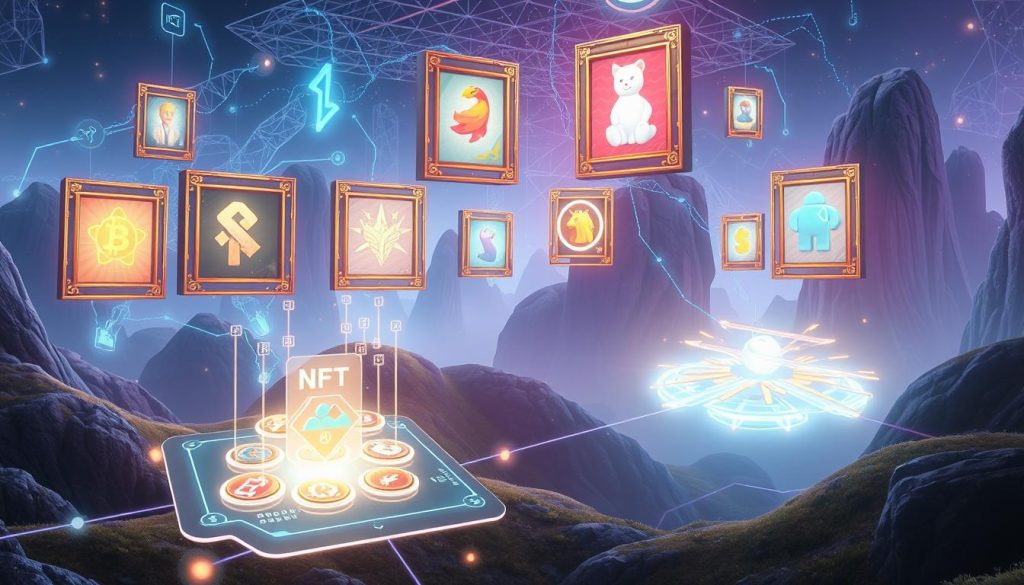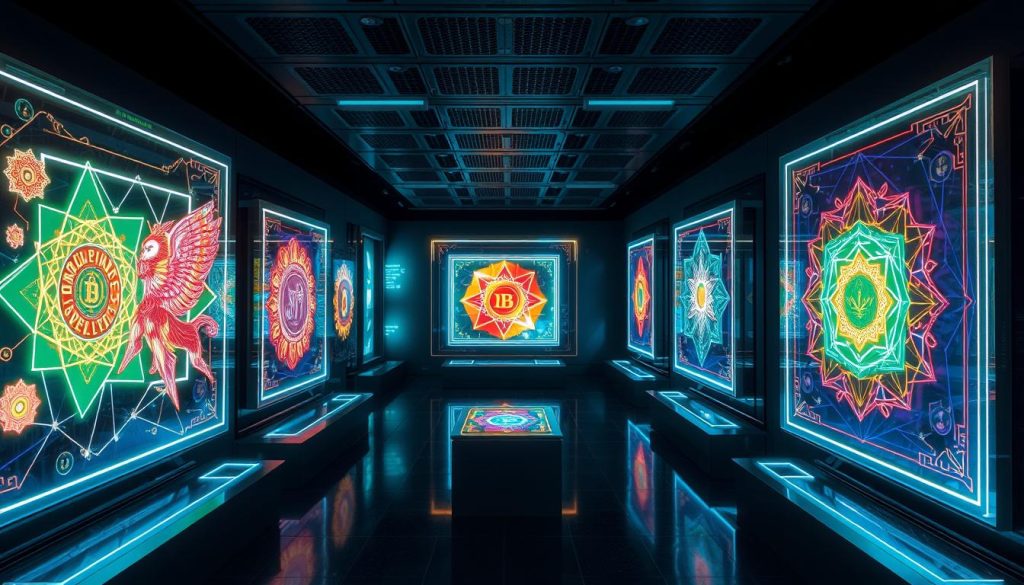In recent years, non-fungible tokens (NFTs) have changed the game in digital art and collectibles. They mix technology and creativity in a unique way. This article, “NFTs Explained: The Future of Digital Art and Collectibles,” dives into this exciting trend.
It shows how digital collectibles are changing what it means to own something online. With sites like OpenSea and Rarible, buying, selling, and trading art has never been easier. As we explore NFTs, we’ll see how they’re shaping the future of art and collecting.
Key Takeaways
- NFTs provide verifiable ownership of digital assets through blockchain technology.
- Digital collectibles have gained massive popularity, leading to new revenue streams for artists.
- NFT platforms, such as OpenSea and Rarible, facilitate transactions of digital art.
- The NFT market is continually evolving, reflecting trends in technology and consumer interests.
- NFTs enable artists to retain royalties on secondary sales, promoting sustainable income.
Understanding NFTs and Their Significance
Non-fungible tokens (NFTs) are changing the game in digital art and collectibles. They redefine what we think about owning things online. Unlike Bitcoin, which can be swapped for another of the same, NFTs are one-of-a-kind. This makes owning digital art a real thing, not just a concept.
What Are Non-Fungible Tokens?
NFTs are digital items that prove they’re real and who owns them, thanks to blockchain. Each one is special, with its own unique data. This makes them super valuable in the world of digital art, where being original matters a lot.
Artists and collectors love NFTs because they create a new market for digital art. It’s all about showing off uniqueness and owning something special.
The Technology Behind NFTs: Blockchain
Blockchain is the tech that makes NFTs work, keeping transactions safe and open. It tracks and moves NFTs, making sure who owns what is always clear. For instance, Ethereum uses ERC-721 to make unique tokens.
This setup builds trust between buyers and sellers. It proves that digital art is real and that ownership matters.
Key Features of NFTs: Uniqueness and Ownership
NFTs stand out because they’re unique and you can own them. Each one has its own ID, making it special and not replaceable. This shows how important owning something is in the NFT world.
Artists can sell their work directly, and collectors can buy unique digital items. This is changing how we see value and ownership in the digital world.

NFTs Explained: The Future of Digital Art and Collectibles
The art market is changing with tokenized art. Artists can now turn their work into digital pieces and sell them as NFTs. This makes each piece unique and proves who owns it.
Artists can sell their work directly to collectors without galleries. This means they keep more of the money they make. It’s a big change for the art world.
Transforming the Art Market with Tokenized Art
Tokenized art has changed how we buy and sell art. Beeple’s “Everydays: The First 5000 Days” sold for $69 million at auction. This shows how digital art can be more valuable and easier to get for collectors.
Artists can make many copies of their work as NFTs. This opens up new ways for them to make money and get their work seen by more people.
The Rise of Digital Ownership
NFTs give artists tools like smart contracts. These contracts help sell art and make sure artists get paid when it’s sold again. It’s a way for artists to connect directly with collectors.
This cuts out the middlemen and lets artists control their money better. It’s a big change that puts artists back in charge of their careers.

The NFT Market: Trends and Growth
The NFT market has seen a huge surge in interest, with a focus on digital collectibles. Platforms like NBA Top Shot are leading the way. They offer unique, tokenized moments that let collectors own their favorite sports memories.
Cryptocurrencies play a big role in this market. They change how we see and do transactions. The mix of market demand and cryptocurrency ups and downs affects everything from prices to investment chances.
Current Trends in Digital Collectibles
Many trends are changing the NFT market. From virtual trading cards to gaming items, digital collectibles are drawing in a wide range of people. Platforms focused on specific areas, like sports or art, have created special markets.
This has led to more community involvement and investment. Items that were once just part of a game now have real value as NFT collectibles. Even augmented reality is being used, making these items more interactive.
How Cryptocurrency Influences the NFT Market
The link between the NFT market and cryptocurrency is deep. Prices of digital collectibles often move with cryptocurrency values, like Ethereum. This means market ups and downs can affect the value of digital art and collectibles.
As cryptocurrency art grows, it’s key to understand these changes. This knowledge helps both collectors and creators in this ever-changing world.
| Trend | Description | Impact on NFT Market |
|---|---|---|
| Virtual Trading Cards | Collectible items featuring athletes, musicians, and more | Increased engagement and community building |
| Gaming NFTs | In-game assets that can be bought, sold, or traded | Enhanced monetization opportunities for developers |
| Augmented Reality Art | Interactive pieces that enhance user experience | Attracts a broader audience interested in tech |
| Ethereum Transactions | Transaction speed and cost implications for buying NFTs | Influences market accessibility and investment |
The Influence of NFTs on Artists and Collectors
NFTs have changed the digital art world a lot. They have opened new ways for artists to make money. They also change how collectors see value in art. It’s important to know how NFTs help artists and change how collectors think.
Empowering Creators through NFT Platforms
Platforms like Foundation and Nifty Gateway help artists a lot. They let artists create, show, and sell digital art worldwide. This means artists don’t have to rely on old galleries or be limited by where they are.
Artists can also make money from future sales. This is a big change for how artists make money.
The Collector’s Perspective: Investing in Digital Art
For collectors, NFTs offer special chances to invest in digital art. They like the rare and unique things NFTs offer. This lets collectors own special pieces and know they are real thanks to blockchain.
This makes collectors proud and brings them together. They share their love for art with others.
As NFTs grow, creators and collectors must learn to adapt. Knowing about these changes is key to enjoying the digital art world.
| Aspect | Creators | Collectors |
|---|---|---|
| Revenue Streams | Royalties on resales, direct sales | Potential appreciation of value |
| Community Engagement | Collaboration and networking opportunities | Interaction with like-minded collectors |
| Ownership | Secured through blockchain | Verified authenticity and rarity |
| Market Reach | Global audience via online platforms | Access to diverse digital art collections |
Conclusion
NFTs are changing the digital art world in big ways. They offer clear proof of ownership, making art and collectibles more secure. Artists can now share their work with more people, reaching audiences they never could before.
NFTs do more than just help with sales. They change how we see ownership online. In a world where digital items can be copied easily, NFTs make each piece unique. This lets collectors buy digital items with confidence, knowing they own something real.
The growth of NFTs is a big deal for the art world. It brings artists, collectors, and fans closer together. As we see more new things in this area, it’s clear that NFTs are here to stay. They’re not just a passing trend but a major shift in how we think about art.
FAQ
What are NFTs and how do they work?
NFTs, or non-fungible tokens, are unique digital assets. They show ownership of a specific item or content on the blockchain. Unlike Bitcoin, each NFT is unique, proving its authenticity and ownership.
How do I buy NFTs?
To buy NFTs, you need a digital wallet that supports cryptocurrency. First, set up your wallet and buy Ethereum. Then, visit marketplaces like OpenSea or Rarible to buy digital collectibles with your wallet.
What role does blockchain play in NFTs?
Blockchain technology is key to NFTs. It keeps a record of ownership and transactions that can’t be changed. This proves each NFT’s authenticity and ownership.
Can artists benefit financially from NFTs?
Yes, artists can greatly benefit from NFTs. They can sell their artworks directly to collectors and earn royalties on resales. This way, they can make more money without needing galleries or middlemen.
What types of digital assets can be turned into NFTs?
Many digital assets can become NFTs, like artwork, music, videos, and even tweets. This lets creators from different fields find new ways to make money.
What is the significance of digital ownership in the NFT space?
Digital ownership in NFTs adds value and provenance to digital assets. It lets collectors own digital art and collectibles with verified authenticity. This makes buying, selling, or trading them more secure.
How is the NFT market evolving?
The NFT market is growing fast, thanks to digital collectibles and cryptocurrency art. New platforms and technologies are coming out. This keeps changing the market and opens up new chances for creators and collectors.
What are some popular platforms for buying and selling NFTs?
Top platforms for NFTs include OpenSea, Rarible, Foundation, and Nifty Gateway. These places let artists and collectors trade digital art and collectibles. They offer a wide range of options.
Read More: Revolutionizing Decentralized Finance (DeFi) in Financial industry




